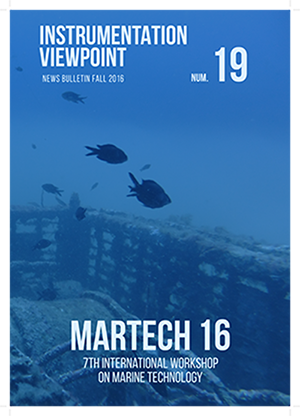Multibeam systems for the detection of gas flares in the water column
Abstract
Wärtsilä ELAC Nautik is one major global player in the multibeam business. The multibeam systems are marketed under the well-known brand name SeaBeam, including systems for medium water depth and deep-water areas. The ELAC SeaBeam 3012/3020 deep-water systems operate in the 12 kHz and 20 kHz frequency bands, whereas the ELAC SeaBeam 3030/3050 medium-depth systems operate in the 30 kHz and 50 kHz frequency bands. While formerly only continuous wave (CW) pulses were applied, the new Mk II series of the ELAC SeaBeam 3030/3050 multibeam systems offer the possibility to apply frequencymodulated (FM) pulses for increased measurement ranges, improved range resolution and better data quality. FM pulses require a correlation of the beamformed data of all beam directions with pulse replica in order to obtain pulse compression. Additionally, Doppler shifts of the operating frequencies induced by the ship’s movement have to be compensated. In order to obtain unrivalled data quality, the ELAC SeaBeam 3030 / 3050 multibeam ystems apply Doppler compensation not only on the bathymetric depth data, but also on the water column imaging (WCI) data. In order to provide high data density, all ELAC SeaBeam MBES can transmit two quasisimultaneous swaths per ping cycle, which are frequency-separated. Compared to the singleping mode, the data density is doubled. The ELAC SeaBeam 3030/3050 multibeam systems include a functionality for to automatic cyclical steering of the transmitted swaths in the along-ship direction. Via this functionality, which is called “Advanced Transmission Beam Steering”, an entire volume below the vessel can be insonified without requiring any movement of the vessel. The operator can specify an angle range and an angle increment, resulting in a periodic oscillation of the transmitted swaths from bow to aft and vice versa. This functionality is very helpful for the detection and analysis of gas flares, leakages or other objects in the water column during stationary vessel operation or on fixed platforms. Wärtsilä ELAC Nautik GmbH Page 2 of 3 31. May 2016 On order to provide highest operational flexibility, the ELAC SeaBeam 3050 and ELAC SeaBeam 3030 are available as mobile systems, providing the sonar electronics in flight cases and utilizing mobile transducer brackets for spatial resolutions of 1.5° x 2° for ELAC SeaBeam 3050 and 3° x 2° for ELAC SeaBeam 3030. Wärtsilä ELAC Nautik is the only supplier, offering a mobile 30 kHz multibeam of the sea water profile and sea water surface will be designed, studied, developed and applied to a real situation. A thermometer, based on distributed temperature sensor, will be designed, paying special attention to the involved materials, in order to avoid the damages of such corrosive environment. Nowadays, this techique is used in many infraestructures as bridge or airports by never has been used in sea, where the sea currents and biofouling are problems that will are wtudied at the project. However the optical fibers must been calibrated to know the uncertainty in temperature measure, and it is the purpose of the paper. system with a depth performance of more than 6,000 meters. Wärtsilä ELAC Nautik is a main industrial partner within the German „Lighthouse“ Research Project SUGAR (Submarine Gas Hydrate Reservoirs) and cooperates with the GEOMAR Helmholtz Centre for Ocean Research Kiel. Wärtsilä ELAC Nautik participates in a SUGAR subproject, which is related to gas flare detection. Gas flares at the seabed are indicators for potential gas hydrate reservoirs and potential leakages of gas deposits. Therefore, gas flare detection is important for the exploration of submarine gas hydrates and for environmental monitoring. Driven by the SUGAR project, the ELAC SeaBeam multibeam systems store WCI data with very high resolution. For the online and offline visualization of high-resolution WCI data, the ELAC WCI Viewer is utilized, providing different window types for data visualization, different scaling and range options, forward and backward data playback as movies or single pictures, object and event functionalities and the display of external sensor data. These capabilities help to identify and analyze any kinds of objects in the water column or on the bottom (e.g. gas seeps). Despite helpful aids for the online visualization of high-resolution WCI data, there is a need for an automatic processing of WCI data with respect to object detection. Such automatic processing will reduce the workload of survey operators significantly. Therefore, Wärtsilä ELAC Nautik has developed an automatic object detector (ELAC AOD) which is dedicated to gas flares in the water column. Due to the huge data volumes of high-resolution WCI data, the development of the ELAC AOD was ambitious and challenging. The ELAC AOD was implemented within the MATLAB development environment. The ELAC AOD is dedicated to WCI data from ELAC SeaBeam 3030 and 3050 medium-depth multibeam systems and stores all relevant information of detected objects in so-called object log files. It is possible to import such object log files into the ELAC WCI Viewer for visualization purposes. Due to the above-mentioned characteristics, multibeam systems from Wärtsilä ELAC Nautik are excellently applicable in order to detect and analyze gas flares in the water column. The presentation will provide detailed system information and important data examples.Downloads
Issue
Section
License
Universitat Politècnica de Catalunya has joined the Berlin Declaration on Open Access to Knowledge in the Sciences and Humanities. This declaration proposes the universal acces to the results of scientific and technical research.
All papers presented at Martech will be published in both the UPCommons and the Martech organization web sites, the former being the institutional digital deposit of Universitat Politècnica de Catalunya (https://upcommons.upc.edu). This difussion will be made through the Creative Commons License Attribution-NonCommercial-NoDerivs 2.5 or similar (http://creativecommons.org/licenses/by-nc-nd/2.5/deed.en).
When sending the final paper, the author must agree to the conference having non-exclusive rights on this operation. The author will maintain his/her right to diffuse the paper elsewhere.







